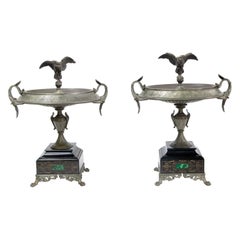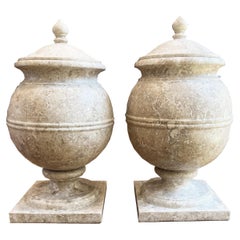Spelter Garniture
5
to
2
4
1
5
5
5
1
1
3
2
2
1
1
Height
to
Width
to
516
229
211
111
109
5
3
2
2
Material: Spelter
Pair of Ornamented Vases or Lamps with Little Angels and Richly Decorated
Located in Verviers, BE
Pair of ornamented vases or lamps with little angels and richly decorated on Marble Base
As Service we can also make ornamental lamps out of it see ...
Category
Early 1900s French Antique Spelter Garniture
Materials
Carrara Marble, Spelter
Pair of Antique French Neoclassical Style Urns
Located in Houston, TX
Pair of antique French Neoclassical style Urns.
Great pair of 19th century French Neoclassical style bronzed metal urns on marble bases. These stunning antique French Grecian style u...
Category
1920s French Neoclassical Vintage Spelter Garniture
Materials
Marble, Spelter
Pair of 19th Century French Louis XVI Mantel Urns on Marble Bases
Located in Dallas, TX
Pair of 19th century French Louis XVI mantel urns on marble bases were intended for decorative appeal alone, and feature classic designs inspired by ancient Greek amphora...
Category
1890s French Louis XVI Antique Spelter Garniture
Materials
Marble, Spelter
Pair of 19th Century Copper Plate Spelter Ewers
Located in San Francisco, CA
Pair of 19th century copper plate spelter ewers
Dimensions 6.25" x 6.5" at the base x 20.5" high
Very good antique condition.
Category
Late 19th Century English Antique Spelter Garniture
Materials
Spelter
Pair of Spelter and Marble Comports
Located in Wilson, NC
Pair of Spelter and marble comports have center finials of winged eagles, the Rococo base with hairy paw feet. They are each inlaid with a malachite panel.
Category
1880s English Antique Spelter Garniture
Materials
Malachite, Marble, Spelter
Related Items
19th Century Copper Vessel
Located in Gloucestershire, GB
19th Century patinated copper vessel with iron handles.
Category
19th Century British Industrial Antique Spelter Garniture
Materials
Copper, Iron
Pair of Marble Urns
Located in Scottsdale, AZ
Elevate your home or garden with this exquisite pair of marble urns, each a masterpiece of design and craftsmanship. These solid, heavy urns undersc...
Category
21st Century and Contemporary Spelter Garniture
Materials
Marble
Antique Pair English Staffordshire Porcelain Table Lamps Ridgway or Rockingham
Located in Dublin, Ireland
An exceptionally fine pair of English Staffordshire Porcelain mantle vases now converted to electric table lamps of medium proportions, Circa 1860.
Of traditional bulbous outline ...
Category
19th Century English Early Victorian Antique Spelter Garniture
Materials
Ormolu
H 15.25 in W 6.25 in D 4.25 in
Pair of Neoclassical Garden Urns
Located in West Palm Beach, FL
This stylish set of English 19th century cast iron Neoclassical Revival garden urns were acquired from a Palm Beach estate.
Note: Dimensions of square bases are 8.25" width x 8.1...
Category
Late 19th Century English Neoclassical Revival Antique Spelter Garniture
Materials
Iron
19th Century Satsuma Vase or Lamp
Located in Brighton, Sussex
A good quality late 19th century (Meiji period 1868-1912) Japanese satsuma vase or lamp. Having classical gilded decoration of flowers, birds and scholars. Mounted on a fretted ormol...
Category
Late 19th Century Japanese Antique Spelter Garniture
Materials
Porcelain
Pair of Porcelain Vases Ormolu-Mounted in Lamps by Gagneau Paris XIXth Century
Located in Saint-Ouen, FR
Pair of large Japanese Porcelain Cone Shape Vases with Imari decoration
Important mounts in ormolu and gilded metal, the base decorated with a laurel wreath, the upper part of falling leaves and a frieze of knotted ribbon.
The mounts signed Gagneau, 115 R. Lafayette.
Circa 1860
With their original aluminium bulb cover and original gilding
Vase it self Height 47 cm
The Gagneau Company is one of the most famous lighting factories in Paris in the nine-teenth century, established in 1800 at 25 rue d'Enghien in Paris and later at 115 rue de Lafayette. She has participated in many exhibitions throughout this century. She began in 1819 with the Exposition des Produits de l'Industrie and later participated in the Universal Exhibitions where she was part of the jury in the category of art bronzes (class 25) at the Universal Exhibition in Paris in 1889.
"Imari" was simply the trans-shipment port for Arita wares, from where they went to the for-eign trading outposts at Nagasaki. It was the kilns at Arita which formed the heart of the Japanese porcelain industry.
Arita's kilns were set up in the 17th century, after kaolin was discovered in 1616. A popular legend attributes the discovery to an immigrant Korean potter, Yi Sam-Pyeong (1579–1655), although most historians consider this doubtful. After the discovery, some kilns began to produce revised Korean-style blue and white porcelains, known as Early Imari, or "Shoki-Imari".
In the mid-17th century, there were also many Chinese refugees in northern Kyushu due to the turmoil in China, and it is said that one of them brought the overglaze enamel coloring technique to Arita. Thus Shoki-Imari developed into Ko-Kutani, Imari, and later Kakiemon, which are sometimes taken as a wider group of Imari wares. Ko-Kutani was produced around 1650 for both export and domestic market.Kutani Ware is characterized by vivid green, blue, purple, yellow and red colors in bold designs of landscapes and nature. Blue and white porcelain pieces continued to be produced and they are called Ai-Kutani. Ko-Kutani Imari for the export market usually adopted Chinese design structure such as kraak style, whereas Ai-Kutani for the domestic market were highly unique in design and are ac-cordingly valued very much among collectors.
Ko-Kutani style evolved into Kakiemon-style Imari, which was produced for about 50 years around 1700. Kakiemon was characterized by crisp lines, and bright blue, red and green designs of dramatically stylized floral and bird scenes. Imari achieved its technical and aes-thetic peak in the Kakiemon style, and it dominated the European market. Blue and white Kakiemon is called Ai-Kakiemon. The Kakiemon style transformed into Kinrande in the 18th century, using underglaze blue and overglaze red and gold enamels, and later additional colors.
Imari began to be exported to Europe when the Chinese kilns at Jingdezhen were damaged in the political chaos and the new Qing dynasty government halted trade in 1656–1684. Ex-ports to Europe were made through the Dutch East India Company, and in Europe the des-ignation "Imari porcelain" connotes Arita wares of mostly Kinrande Imari.
Export of Imari to Europe stopped in mid-18th century when China resumed export to Europe, since Imari was not able to compete against Chinese products due to high labor costs. By that time, however, both Imari and Kakiemon styles were already so popular among Eu-ropeans that the Chinese export porcelain copied both, a type known as Chinese Imari. At the same time, European kilns, such as Meissen and English potteries such as Johnson Bros. and (Royal) Crown Derby, also imitated the Imari and Kakiemon styles.
Export of Imari surged again in late 19th century (Meiji era) when Japonism flourished in Europe.Thus, in the western world today, two kinds of true Japanese Imari can...
Category
1880s French Japonisme Antique Spelter Garniture
Materials
Bronze
H 38.59 in Dm 10.24 in
Pair of 19th Century Marble and Ormolu Urns
Located in Brighton, Sussex
A good quality pair of late 19th century French marble and gilded ormolu urns, each with classical Rans head mounts, supported by three out-swept supports, terminating in hoof feet a...
Category
19th Century French Louis XVI Antique Spelter Garniture
Materials
Marble, Ormolu
Pair of Antique Italian Neoclassical Relief Carved Gilt Wood Decorative Urns
Located in Forney, TX
A stunning pair of antique Italian Neo-classical faux marble wooden urns.
Born in Italy around the 18th/early 19th century, sculptural lidded urn architectural element form, hand ca...
Category
18th Century Italian Neoclassical Antique Spelter Garniture
Materials
Enamel
Italian White Ceramic Urns Neoclassical Style, Pair
Located in New York, NY
A pair of Italian white ceramic urns vases, Neoclassical style, circa late-20th century, Italy. Great as standalone pieces or as vases with flowers,...
Category
Late 20th Century Italian Neoclassical Spelter Garniture
Materials
Ceramic, Pottery
Pair 19th Century Spelter & Marble Mantel Urns ~ Cassolettes
Located in Dallas, TX
Pair 19th century Spelter & Marble Mantel Urns ~ Cassolettes are the epitome of late Belle Epoque neoclassicism, and were meant for decorative purposes only. The classic Greek form h...
Category
1890s French Belle Époque Antique Spelter Garniture
Materials
Marble, Spelter
Antique 19th Century Turkish Dovetailed Copper Lidded Jug Pitcher Ewer
Located in Dayton, OH
19th century Turkish dovetailed copper jug / pitcher / ewer with curved handle, bell / acorn shaped brass finial and hinged lid.
Dimensions:
10.5” x...
Category
19th Century Rustic Antique Spelter Garniture
Materials
Copper
H 18.25 in W 10.5 in D 10.5 in
Pair of Italian Neoclassical Style Gilt Bronze Mounted Marble Urns
Located in Milford, NH
A fine pair of Italian Neoclassical style marble urns, with bronze mounts including bronze heads of Satyr or Faun the sides of each urn, bronze bud finials, and a bronze acanthus de...
Category
Early 20th Century Italian Neoclassical Spelter Garniture
Materials
Marble, Bronze, Ormolu
Recently Viewed
View AllMore Ways To Browse
19 Century Bronze Ewer
84 Russian Silver Goblets
Hl Holland
Louis Dage On Sale
Malines Sarreguemine On Sale
Petrus Regout On Sale
Rolex Star City
Benefield Artist
19 Century Chest Of Drawers
Antique Break Front
Antique Chinese Storage Chest
Antique Dutch Marquetry Furniture
Antique Dutch Marquetry
Antique Gustavian Chest
Antique Mirror Wardrobe
Antique Scottish Cabinet
Antique Swedish Painted Chest Of Drawers
Antique Wardrobe Mirror





